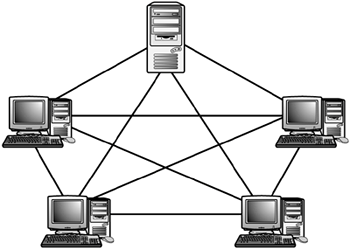
As you can see from Figure 6, the wiring for a mesh network can be very complicated. Further, the cabling costs associated with the mesh topology can be high, and troubleshooting a failed cable can be tricky. Because of this, the mesh topology is rarely used. A variation on a true mesh topology is the hybrid mesh. It creates a redundant point-to-point network connection between only specific network devices. The hybrid mesh is most often seen in WAN implementations. Table 5 summarizes the advantages and disadvantages of the mesh topology.
|
Advantages |
Disadvantages |
|---|---|
|
Provides redundant paths between devices |
Requires more cable than the other LAN topologies. |
|
The network can be expanded without disruption to current users. |
Complicated implementation. |